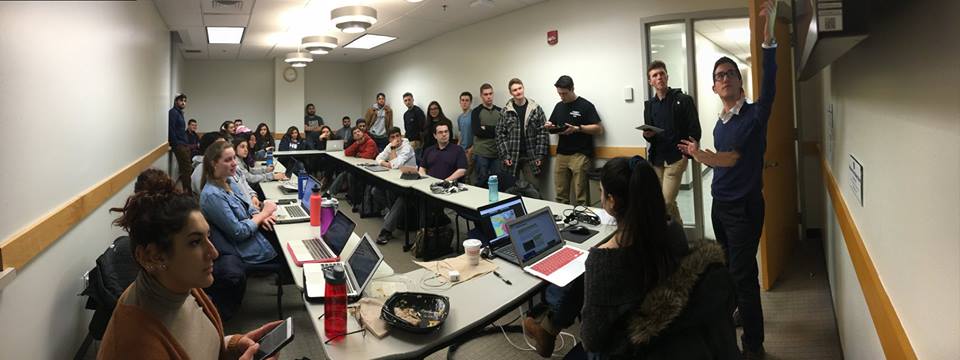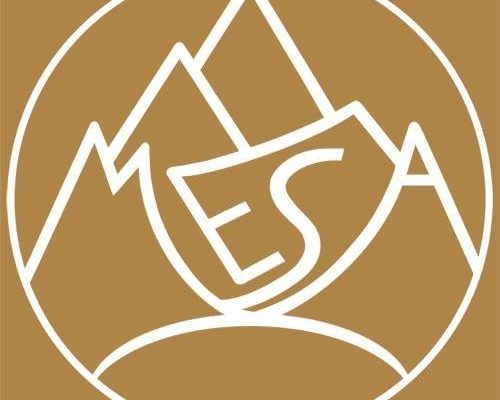By Maria Shah
“My dad’s actually a refugee. He fled Afghanistan in 1989, and he arrived in JFK and like they knew right off the jump that his papers were not legitimate, so he sought political asylum the second that he landed and went through a pretty arduous process to get refugee status, and then, I mean, I was two years old when 9/11 happened. I was just about to turn three, so in my whole mind I have no recollection of a time where it was okay to be Afghan, where it was okay to be Muslim in the United States.”
This is Susan Naseri. Naseri is many things: an Afghani American woman, a political science and human rights double major and a university scholar. However, what some may not know is that Naseri is also the president of the Middle Eastern Students Association, or MESA for short.

Pictured left to right: Lava Kareem (bottom left), Dana Hamad, Susan Naseri, Drew Annabi, Mateen Karimi, and Marlene Abouaassi (bottom right).
Photo: Susan Naseri
“So, most of my life I was battling with these kinds of two identitiesーI was resenting this country for what it was putting me through, and then I was resenting Afghanistan too, like why couldn’t you have sustained yourself? And then, later on in my life, in 2015, we had a really big loss in our family, aboutーit wasn’t aboutーit was eight of my cousins, their boat flipped over, and they all died… About a week later, my uncle passed away from heartbreak. It was a point in my life where I knew that I had an obligation to these people and to this community and that likeーthere’s this term that’s called birth privilegeーI did nothing to be so privileged to be born in New York, you know? So, I don’t know, I always felt like, especially at that point in my life I knew that I needed to do something so that other families, and other people didn’t experience this pain,” Naseri says.
Naseri’s tragic story was shocking, but unfortunately, it is the story of many middle eastern people around the world. However, this story is not about Naseri.
This story is about how the efforts of people like Naseri, may bring another cultural center to UConn.

Photo: UConn MESA.
There are six cultural centers at UConn, and every cultural center has a story. They were born from an incident on campus that caused students to band together and demand a space on campus for their community.
The H. Fred Simons African American Cultural Center was created in 1968 to support African American students in their efforts to have a rewarding university experience. It was a gathering space for students, staff and faculty.
As the years went by, the African American Cultural Center has adapted to the changing needs of future generations of African American students at UConn.
Today, the African American Cultural Center is all this and more, while also staying true to its original mission: the academic and cultural development of African American students and the UConn community.
The Asian American Cultural Center was created in 1993, but the effort began in 1987, when eight Asian American students boarded a bus to attend a semi-formal off-campus.
The students were verbally and physically harassed, and when campus police and university officials did nothing, students took it into their own hands. Eighteen months of protest culminated in the establishment of the Asian American Students Association and the Asian American Faculty & Staff Association, which then worked to create a cultural center.
The remaining four cultural centers: the Puerto Rican/Latin American Cultural Center (PRLACC), the Women’s Center, the Rainbow Center and the Native American Cultural Programs have stories as well, and the efforts of students joining together and demanding their space is the common thread between the cultural centers, interconnecting them forever.
So then, what would a Middle Eastern Cultural Center mean for students? The Middle East includes regions of Western Asia and North Africa, and sometimesーdue to the political associations with the termーparts of South Asia.

Photo: UConn MESA.
Therefore, depending on the country one is from, they geographically may fall under the African American Cultural Center or the Asian American Cultural Center. Naseri points out that due to the cultural differences, this is unfair to not only the Middle Eastern American community here at UConn, but to the African American and Asian American communities as well.
“We picked up the initiative last fall. We have so far met with the director of the Asian American Cultural Center and the African American Cultural Center. And oftentimes, we had these conversations, about: as someone from Afghanistan, yeah I’m from Asia, but my culture is not Asian. AsACC is often tasked with ‘Oh, make events that include this population.’ I don’t think that’s fair that, as Asian students, their experience and their space is compromised to make room for me. That’s not right; that’s a space that was made for them to celebrate their culture. Same with the African American Cultural Center. They’re constantly criticized too, like, ‘What about North Africans?’ and that’s also not fair to them. That’s a space to celebrate black history, and black culture. So, we immediately talked to those directors, because we wanted to get their perspectives and see if we had their support, and they were 100% for it. They were like, ‘Yes we completely understand why you need your own space, we completely support it,’” Naseri says.
After speaking with the directors of both cultural centers, MESA also spoke to Dana Wilder, the Interim Chief Diversity Officer at UConn.
“We had this conversation about how people make the space that they’re in, and that space doesn’t define people, and I was like, yeah no– that’s not– we’re not gonna use that excuse here. Because most cultural centers that are currently on campus were formed, kind of as a retroactive response like, something–an incidentーa horrible incident happened to Asian American students and then they got their space, and after so many black students protested they got their space […] why do I need to wait until something, by your definition, ‘horrible’ happens to my community for you to be like, ‘Oh that was catastrophic enough that now you get to be recognized.’ It’s a very retroactive wayーlike you should be proactiveーI should feel safe before I feel unsafe,” Naseri says.
Naseri emphasized how MESA is different than other cultural organizations in that it is not represented by any religion, and it is apolitical, and she credits this to MESA’s rapid success and growth as a student organization, having been on campus officially, for only one year.

Photo: Susan Naseri
However, establishing a cultural center is a long and arduous process. Even the Asian American Cultural Center, while established in 1993, did not have a permanent home until 2006.
However, MESA is up for the challenge and understands that it is not something that will happen in the current executive board’s time here at UConn. It is why it’s important to start the conversation, so future students can make their dreams a reality.
“A big part of it is getting faculty and staff support, because they know the student support is there,” Naseri says.
Right now, the main concern brought up by the Diversity and Inclusion Office was budgeting and space. MESA was told the importance of creating one’s own space, however, Naseri did not appreciate this answer and voiced the concerns that many in the community feel.
“I think that as a community, especially growing up post 9/11, we have experienced enough trauma, like, my community has gone through enough. So, at this point if you can’t recognize me as a marginalized population that is in need of a safe spaceーthat is in need of a space for my community to heal, like, don’t tell me to keep booking out rooms. Yeah, I can do that forever, but I also need a space that recognizes me,” Naseri says.
The African American Cultural Center, Asian American Cultural Center, and Diversity and Inclusion Office were not available to comment in the time of writing this story.
Update April 5th 2019, 10:06AM: MESA is hoping to name the cultural center the Middle Eastern and South Asian Cultural Center (MESACC), which will be inclusive South Asia as well.


